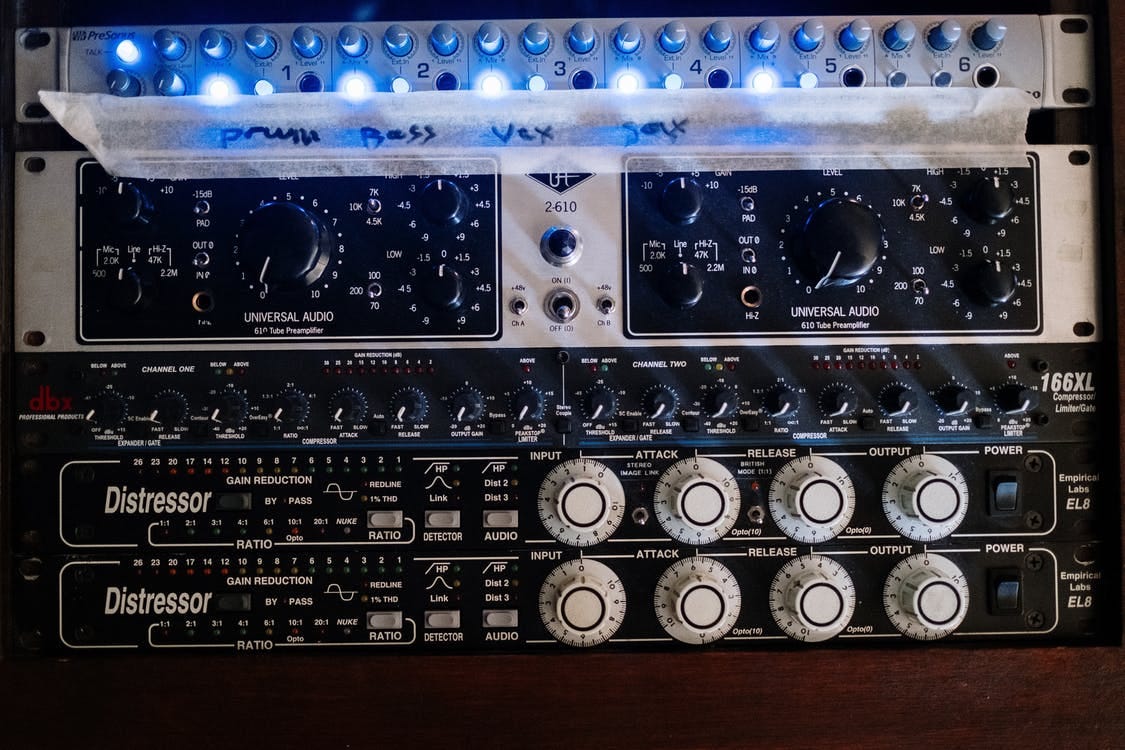
What is a Preamp?
A preamplifier is used for recording audio; it boosts an audio signal by increasing the signal gain. The signal that comes from an instrument, such as a guitar, bass, synthesizer, or microphone, is too weak to be processed by a DAW. This is why these signals are referred to as ‘mic-level’ or ‘instrument-level’. Processing gear requires audio at a higher volume, or line-level signals. To raise the volume of a signal, a preamp takes the audio through a process known as “gain staging”. This means it increases a signal volume while minimizing the noise level to help you achieve the best signal-to-noise ratio.
This equipment is often confused with a phono preamp, or a preamplifier used to boost the signal from a turntable. Although these devices serve a similar purpose, they have different price ranges and specialized features. So, if you need to amplify the audio from your record player, you need a phonographic preamplifier, or a phono stage.
Internal vs. External Preamps
Most audio devices feature built-in preamps. Even computers and phones use preamps, but these are well below the acceptable quality level for music production. Their main purpose is boosting audio signals enough to be played by the device’s speakers. Audio interfaces also use built-in preamps, and these are typically good enough for those starting out in music production. Many people who record music in a non-professional setting rely on internal preamps without even realizing they are using a preamp.
External preamplifiers serve the same purpose, but are separate pieces of equipment. They are commonly used during professional music production to produce a higher quality sound during recording. They can produce more gain with lower noise levels, and depending on the model, can produce a specific sound colorization or character. The most noticeable effect is produced with low output dynamic microphones. High output instruments and condenser microphones will not display as big of a difference between internal and external preamps.
It’s important to know that an external preamp will not improve the quality of your sound if you’re having signal issues to begin with. In other words, a nice preamp can’t make up for a cheap microphone. It will only allow you to get the most out of a good signal. Keep in mind that any amount of gain staging still increases the noise level of your signal to some degree. Therefore, to reduce unnecessary noise when using an external preamp, be sure to run the preamplified signal into the line inputs of your audio interface, rather than running them through the interface’s internal preamp.
Choosing a Preamp
There are many factors to consider when it comes to choosing an external preamplifier that suits your recording needs:
Preamp type: There are two main types of preamps: tube and solid-state. Preamps using tubes or transformers will not only amplify a sound, but will add a certain coloration or harmonic distortion. This is desirable if you want your signal to have a specific flavor or warmth. Sound color is a very subtle effect that is only typically discussed by studio engineers with specific taste. Solid-state preamps amplify sound with transparency, or without adding any coloration.
Number of channels: Of course, you want a preamp that has enough channels to allow you to record all of your instruments at once. Preamps come with a wide range of channel numbers, from one to sixteen or more. Dual channels are useful for recording stereo signals. A higher number of channels may be necessary if you plan to record multiple instruments playing at once, such as recording a full band, or if you would like to use multiple devices without plugging and un-plugging repeatedly.
Maximum gain: Higher quality preamps can produce a higher gain increase on a signal. Low output microphones like ribbons and dynamics can require 50 – 70 dB of gain, so your gain requirement mostly depends on the equipment you are using to record.
Inputs and outputs: Just like any other piece of equipment, you want to ensure it has input and output types that are compatible with your gear. You can also look for features like onboard digital conversion.
In-line processing: Some people prefer channel strips with built-in preamps because these offer onboard processing like EQ and compression while still providing a high quality preamplifier.






